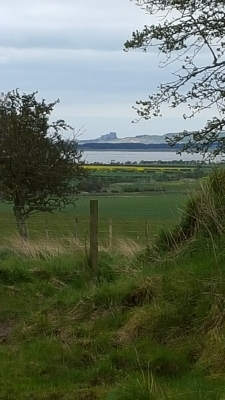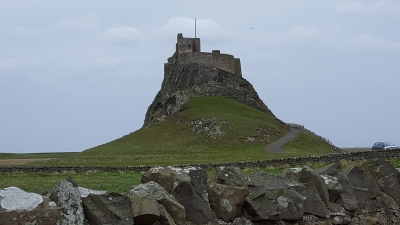
I have just got back from a couple of days walking on and near to Lindisfarne – joined to the mainland at low tide, and an island at high tide. Lots of people drive there – it’s a short detour from the A1 as it heads up towards Berwick and Edinburgh – but there is something very satisfying about doing the journey on foot. Nowadays most people walk along the causeway which also carries the road, but the older pilgrims’ way branches off at an angle and heads more directly for the settlement and priory (now in ruins). The safe period at low tide is shorter here, and there are always a few places where you have to wade.
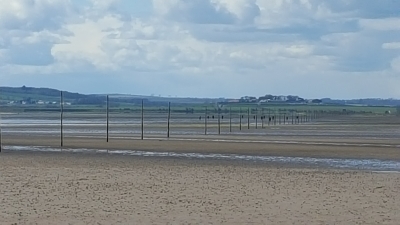
Lindisfarne has gone by several names. Holy Island is one, recognising a long history of sacredness. Christian monks and communities have thrived here since the 6th century, but one suspects that its liminal placing and seclusion marked it out for holiness long before then. The old Welsh name of Ynys Medcaut is thought to refer to the medicinal properties of herbs there.
Alongside the island’s sanctity, its location has meant that periods of conflict have washed across it. One of our first historical notes about the island records a time when an alliance of Briton tribes, led by Urien of Rheged (the North Lake District, basically), tried to capture Theodric of Bernicia (the northern half of Northumberland: the southern half was Deira). After an unsuccessful siege, they withdrew again. But with the rather later arrival of the Vikings, and several centuries of border trouble between England and Scotland, this part of the country became familiar with strife.
And that brings us to Cuthbert. He was born in 635 AD – the same year that St Aidan founded the monastery on Lindisfarne – and although details of his early life are scarce, it seems likely that he was born to a family of some rank. Be that as it may, on August 31st of the year that he was 17 – the very day that Aidan died – he had a vision and spiritual experience which led to him joining the monastery at Melrose. He moved around the north of England for the next decade or so – down to Ripon at one stage, for example – and got a reputation as a cheerful, self-denying, compassionate man with a capacity for imparting spiritual direction as well as bodily healing.

664AD was a significant date in British Christianity – the Synod of Whitby required conformity with certain European traditions, at the cost of local ones. Some of the older forms survived in what is now known as Celtic Christianity, but mainland Britain decided that church unity was worth preserving, and yielded to the demands. Cuthbert was caught up in this, and as some of the previous leadership at Lindisfarne went back to Ireland, he stepped in to a new role as prior – second in command. But after another ten years he took a different step and became a hermit, living a solitary life outside the rules of community.
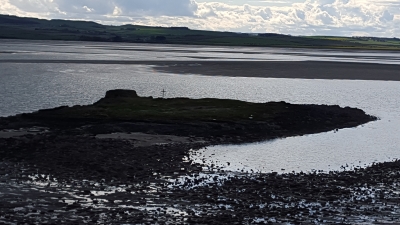
At first he lived in a small cell on an island adjoining Lindisfarne – attached at low tide, separate at high tide, just like Holy Island itself. But after a while he moved out to the more remote Farne islands, inhabited at the time only by seabirds and seals, as indeed it still is today. There are tales of his appreciation of the natural world, with seals coming and resting by his feet as he recited his way through the book of Psalms. Eider ducks are still called ‘cuddies’ to this day in commemoration of him. On good days, boats would set out from the nearby fishing villages to seek counsel, but on rough days, he was left in peace.

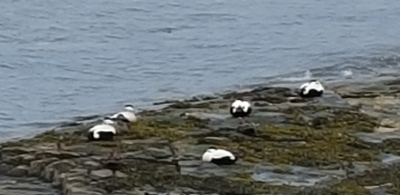
After another decade he was, reluctantly, called out of seclusion in order to take up the role of bishop. He tackled this with fervour, once again travelling widely around the north of England and southern Scotland, but feeling death approaching, he withdrew once again to the Farnes. He died there in 687, after a long illness.
Today a long-distance footpath called Cuthbert’s Way has been set up, and you can retrace his steps (more or less) from Melrose out to Holy Island.
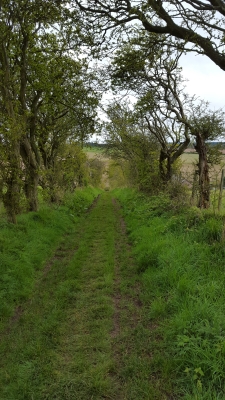
But his story was far from over. For many years he was England’s most celebrated saint, and pilgrims flocked to the sites linked with his activities. However, the times became unsettled, and Vikings started raiding monasteries up and down the coasts. The first raid on Lindisfarne was in 793, and the monastery was finally abandoned in 875. It was considered important to preserve Cuthbert’s body, so it was disinterred and carried from place to place, always keeping one step ahead of the looters – Chester-le-Street,Ripon, and so on. This went on for some time, until Cuthbert, presumably weary of his corpse being trailed about, called a halt. The coffin would not move from a spot in the bend of a river: the bearers, accepting the inevitable, built a cathedral there, and the town of Durham grew up around it.
It seemed that Cuthbert had found his final resting place… until the Reformation when the monastic tradition was under fire, and the stories that his body had never decayed were put to the test. Once again he was interred, and a rather confusing series of examinations by (royalist) doctors took place. In the middle of all this a body was declared perfectly ordinary, and reburied… but confusion remained. Had the body of another monk been substituted, to once again keep the sacred bones out of the hands of pillagers? If you believe that version, then the secret of the real location has been passed down within a select band of Benedictines (who had assimilated “St Cuthbert’s Folk” after the Norman Conquest), generation to generation. Perhaps one day he will come back to a restored and reunited church?
